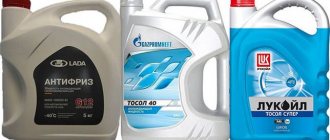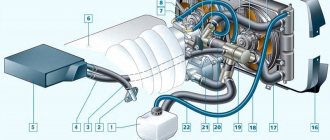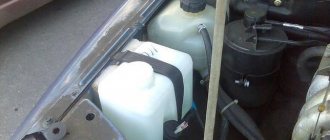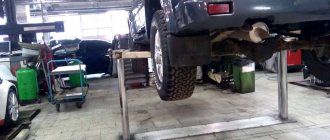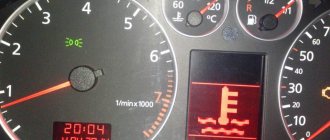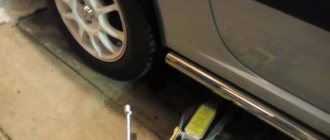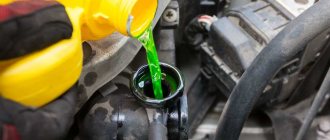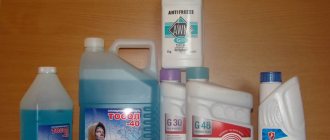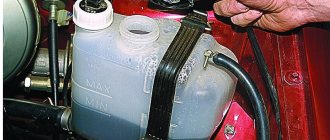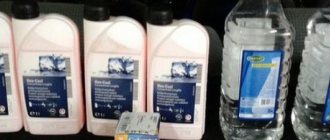The Niva SUV, in all modifications, is very popular in Russian spaces. This is due to good maintainability, low price and excellent maneuverability. To ensure reliable operation, you should undergo all maintenance on time, in particular, replace the coolant.
The liquid system with forced circulation of the VAZ 21214 car is designed for effective heat removal. It fully copes with its task, you just need to keep it in good condition.
Replacing antifreeze VAZ 21214
Replacing the coolant is a regulated maintenance procedure, which is prescribed in the operating instructions. There is nothing complicated about it if you clearly and carefully follow the described action plan.
Suitable for Niva cars:
- VAZ 21214
- VAZ 21213
- VAZ 2121
- VAZ 2131
Before you start replacing the coolant, to avoid getting burned, you need to wait until the engine has completely cooled down. You should also avoid getting antifreeze or antifreeze on the skin, eyes or digestive organs, since the chemical composition of the liquids is toxic.
Coolant drain
Before starting the draining procedure, you should prepare tools, containers for used antifreeze, as well as new liquids for subsequent refilling. If protection is installed under the engine, it can also be removed for convenience.
- turn the temperature regulator in the cabin to the maximum position to the right (Fig. 1);
- place a drain container under the radiator;
- we find the plug in the bottom left corner of the radiator and unscrew it (Fig. 2);
- We put a hose on the drain neck with an internal size of 16 mm and lower it into the drain container. This will prevent antifreeze from splashing;
- after that, unscrew the plug on the radiator filler neck to drain the liquid faster (Fig. 3);
- unscrew the fastening of the expansion tank and lift it up (Fig. 4). In this case, the liquid will drain through the radiator drain hole. And the tank itself can be completely removed and washed;
- To drain the coolant from the engine, you need to unscrew the drain bolt using a 13mm wrench. The bolt itself is located on the left side (Fig. 5).
After completing this operation, do not forget to put the expansion tank in place and also tighten all the drain plugs.
Flushing the cooling system
If there are deposits in the drained liquid or there is a transition from antifreeze to antifreeze, the system should be flushed. To do this you need to do the following:
- Flush the system with plain water through the expansion tank of the VAZ 21214. The plugs must be open;
- tighten the drain plug and bolt;
- fill the system with a flushing agent (you can use Liqui Moly Kuhlerreiniger or Lavr cooling system flush) with distilled water (6-7 liters);
- start the engine. Warm up to 90 degrees;
- leave it idling for 5-10 minutes, depending on the contamination of the system;
- muffle it. Allow the engine to cool to approximately 60 degrees;
- drain the flush using the same steps as removing the old fluid;
- tighten both plugs;
- fill with distilled water to rinse the cooling system;
- start the car and warm up to 90 degrees;
- turn off and let cool to 60 degrees, drain;
- repeat steps 8, 9, 10 and 11 if necessary.
Filling antifreeze into Niva 21214, 21213 without air locks
To fill new fluid into the cooling system, you can use the instructions described in the book on car repair and operation. But when doing this, motorists very often end up with air jams.
Air locks can cause the engine to overheat and boil. And also the heating stove in VAZ 21214, VAZ 21213 (Niva) may not work.
So, let's start filling it correctly:
- before filling, unscrew the hoses supplying antifreeze to the throttle valve heating unit and lift them slightly up (Fig. 1);
- remove the plug from the filler neck of the radiator and begin to fill in antifreeze until it is completely filled (Fig. 2);
- after this, we begin to expel air from the upper radiator pipe (Fig. 3). By pressing and pulling it with your hand towards the filler neck. When performing this procedure, air bubbles should appear in the neck;
- we twist something like a funnel out of a plastic bottle and insert it into one of the pipes (Fig. 4);
- We begin filling through the funnel until the liquid reaches the upper edge of the radiator filler neck. Screw the lid on it tightly;
- After this, we continue filling through the funnel until antifreeze flows from the second pipe. We put both pipes in place and tighten the clamps (Fig. 5);
- pour antifreeze into the expansion tank a few centimeters above the MIN mark;
- We start the car, warm it up to operating temperature, let it run for 5 minutes, then turn it off.
The filling of the liquid is completed, all that remains is to wipe off the spilled antifreeze and wait for the engine to cool. With the car now cooled down, check the level in the expansion tank again and top up if necessary.
Stage one
You should start by draining the used antifreeze . It is recommended to remove the crankcase protection and move it to the side. It is fastened with standard 13 bolts. The protection is neatly removed to the side. After this, the antifreeze is drained. The process looks like this:
- When the engine has cooled down, the heater levers are pushed back all the way.
- Use pliers to disconnect the receiver heating hose. This is done to bleed excess air from the system. In older models with a carburetor fuel supply system, the carburetor heating hose is disconnected.
- A container for used antifreeze is installed under the drain hole on the radiator.
- The drain valve on the radiator opens. If necessary, it is pre-treated with WD-40. To speed up the draining process, remove the radiator filler cap. All the liquid is drained, to the last drop.
- Next, the antifreeze is drained from the internal cooling circuit located in the engine. Use a 13 key to unscrew the plug on the left side of the cylinder block. It is located near the spark plug of the fourth cylinder. A hose is placed under the drain hole and the used coolant is drained through it. The plug is then screwed into place.
- The expansion tank is carefully unscrewed. Then it rises above the level of the radiator - 30-40 cm is enough. The hose going to the radiator is disconnected and sent to the drain container. The tank is washed if necessary, then installed in its original place. The remaining fluid is drained from the radiator again.
In total, there are about 10 liters of antifreeze in the system. Therefore, it is worth paying attention to the volume of drained liquid . Here we must remember: the liquid from the cooling circuit evaporates very reluctantly. Therefore, even in hot weather, the volume of antifreeze in the system decreases very slightly. And if the used antifreeze is less than normal, then it is advisable to check the cooling circuit for leaks or damage.
Replacement frequency, how much and what kind of fluid is needed
According to the manufacturer's recommendation, it is necessary to replace antifreeze or antifreeze on VAZ-21214 cars every 3 years or after a mileage of 60 thousand kilometers. If the car is used in more severe conditions, then it is advisable to replace it more often - every 30-40 thousand kilometers.
- loss of coolant properties. You can check the quality of the antifreeze used using a test strip, which is sold in the same places where the liquid itself is sold. Place the strip in the expansion tank, then pull it out. The strip comes with a color scale, according to which you can understand how much longer the car can be used before replacing the coolant;
- change in color of the coolant to tan or red. This means that rust has appeared in it;
- the appearance of sediments, flakes and dense formations in the liquid.
In all cases, it is necessary not only to replace, but also to check the entire engine cooling system for serviceability.
The coolant for the VAZ 21214 Niva injector should have a freezing point no higher than -40 degrees. Typically, the manufacturer fills in TOSOL TS-40 (manufacturer in Dzerzhinsk). When replacing antifreeze, it can be replaced with antifreeze with G12 approval; it is safer for the entire cooling system. You can also use original Lada G12 antifreeze, which is suitable for all cars of this manufacturer.
Antifreeze volume table
Power unit
The engine installed on the modern model of the Niva 21213 (214) car was inherited from its Soviet progenitor - the VAZ 2121, and in terms of fluid volumes they are almost identical:
- Liquid cooling system. Filled with antifreeze in an amount of 10.7 liters with a freezing point not higher than -40 ° C. The capacity of the interior heating radiator is also included in this volume.
- Crankcase. Motor oils are poured here, the brand of which depends on the operating conditions. Capacity: 3.75 liters, including oil filter filling.
The viscosity of the oil poured into the Niva engine must correspond to the outdoor temperature at which the car is operated. Possible modes and suitable oil brands are shown in the table:
When flushing the power unit during the process of replacing liquid lubricant, the same amount of flushing oil (3.75 l) is used, taking into account the size of the filter. Replacement is carried out after 8-12 thousand kilometers, depending on the quality of the oil. Flushing is usually performed after 3 engine lubricant changes. During operation, it is important to monitor the oil level in the engine crankcase using a special dipstick. If the level drops below the Min mark, it is urgent to add lubricant to the engine of the same viscosity as was previously filled.
Antifreeze needs to be updated at least once every 3 years or according to the degree of wear of the fluid. It is not recommended to dilute antifreeze with distilled water, either in winter or summer. In winter, the diluted liquid may freeze, and during the summer heat it may boil ahead of time, which will lead to overheating of the engine.
Replacing the heater valve VAZ 21214 Niva without draining antifreeze
Niva cars sometimes have problems associated with the failure of some parts of the cooling system, such as a thermostat or pump. If they break down, they are replaced as an assembly, fortunately they are not expensive. Also a common problem are leaking hoses or a cracked expansion tank, which also needs to be replaced.
But there is another problem with the VAZ 21214, a leaking heater valve. Because of this, there may be a smell of antifreeze in the cabin, wet floor mats on the front passenger side, or the heater may not work.
There are several ways to replace a faulty faucet:
- complete draining of antifreeze from the system;
- clamp the stove pipes with special clamps;
- Place your Niva on a slope, with the hood down.
But there is another option that is more clear and simple. To do this, you need to disconnect the pipes going to the stove under the hood, point them upward and fix them in this position. The next step is to remove the stove itself:
- unscrew the console;
- disconnect the latches securing the stove;
- there is no need to disconnect the buttons;
- move the radiator assembly, along with the tap and pipes, towards the driver;
- we take out the entire structure through the space between the steering wheel and pedals;
- That's it, you can change the tap itself.
After replacement, reassemble in reverse order. As you can see, this operation is quite simple, and antifreeze will not leak into the cabin. And the procedure takes only 40 minutes, even for an unprepared person.
Stage two
The next step is flushing the system . It is required when the circuit is heavily contaminated or when switching to another type of antifreeze. For example, when the original coolant for a VAZ 21214 is replaced with compounds from other manufacturers. They differ in the set of additives and composition, and they cannot be mixed.
There are three washing options. The method should be chosen based on the operating conditions of the vehicle. Antifreeze residues and dirt are washed out using the following means:
- Distilled water.
- Household chemical solutions.
- Special cleaning products.
Video
FILLING CAPACITIES
| Refillable system | Volume, l |
| Fuel tank (including reserve) | 42 (65*) |
| Engine cooling system (including interior heating system) | 10,7 |
| Engine lubrication system (including oil filter) | 3,75 |
| Gearbox housing | 1,6 |
| Rear axle housing | 1,3 |
| Steering gear housing | 0,18 |
| Transfer case housing | 0,79 |
| Front axle housing | 1,15 |
| Hydraulic clutch system | 0,2 |
| Hydraulic brake system | 0,535 |
| Windshield and headlight washer reservoir | 2,8 |
| Rear window washer reservoir | 2,0 |
| Power steering reservoir | 1,7 |
* For VAZ-2131 cars and its modifications.
Quantity, l
| Refueling or lubrication point | Name of materials | |
| Fuel tank | Motor gasoline with octane number 91–93, 95* | |
| Engine cooling system including interior heating system | Coolant with a freezing point no higher than –40°C | |
| Engine lubrication system, including oil filter, at ambient temperature: | Motor oils (with API quality level: SG, SH, SJ) | |
| from –20° to +45°С | ||
| from –25° to +35°С | ||
| from –25° to +45°С | ||
| from –30° to +35°С | ||
| from –30° to +45°С | ||
| Gearbox housing | Gear oils with quality level according to API GL-5 and viscosity 75W-90 | |
| Transfer case housing | ||
| Front axle housing | ||
| Rear axle housing | ||
| Steering gear housing | Gear oil 75W-90 | |
| Hydraulic clutch release system Hydraulic brake system | 0,2 0,515 | Brake fluid DOT-3, -4 |
| Windshield washer reservoir Tailgate washer reservoir | A mixture of water and windshield washer fluid | |
| Starter drive drive ring | ||
| Front wheel bearings | Litol-24 lubricant or imported analogues | |
| Cardan joint cross bearings | Lubricant Fiol-2U, No. 158 or imported analogues | |
| Front propeller shaft spline | Lubricant Fiol-1, CV joint-4 or imported analogues | |
| Door limiters | Grease Shrus-4 | |
| Seat moving slides | ||
| Tie rod joints and front suspension ball pins | ShRB-4 lubricant or imported analogues | |
| Battery leads and terminals, door keyholes | Automatic lubricant VTV-1 in aerosol packaging, CIATIM-201, -221, Litol-24 or imported analogues | |
| Door locks | Fiol-1 lubricant or imported analogues | |
| Rear brake pressure regulator | Lubricant DT-1 or imported analogues |
*For vehicles with fuel injection system equipped with an exhaust gas converter
Transmission
The Niva 4x4 transmission system has the following filling volumes:
- transfer case - 0.79 l;
- gearbox - 1.6 l;
- rear axle - gearbox - 1.3 l;
- front axle - crankcase - 1.15 l;
- steering column - crankcase - 0.18-0.2 l.
As with the operation of a power unit, under different temperature conditions, transmission units and assemblies are filled with oils of different viscosities, which is reflected in the table:
As stated in the operating instructions, transmission lubricants need to be changed once every 30 thousand km. mileage At the same time, replacement is not provided for in the steering mechanism housing, only an addition through the top plug. The “native” oil for Zhiguli transmission units is considered to be TAD17I.
Transmission oils have good penetrating ability. Therefore, poorly clamped plugs and worn gaskets of units begin to gradually leak lubricant. In such situations, it is allowed to add oil of the same viscosity class and, preferably, the same manufacturer. If you do not top up during a leak, the lubricant level in the unit will decrease, which will lead to accelerated wear of expensive mechanisms.
Motor oils
| Oil brand | SAE viscosity grade | Group | Manufacturer | Regulatory document | |
| AAI | AP1 | ||||
| LUKOIL LUX | 5W-30, 5W-40 10W-40,15W-40 | B5/D3 | SJ/CF | STO 00044434-003 | |
| LUKOIL LUX | 0W-40, 5W-20, 5W-30, 5W-50, 10W-30 | B5/D3 | SL/CF | LLC "Lukoil-Permnefteorg-sintez", Perm | STO 00044434-003 |
| TNK SUPER | 5W-30, 5W-40 10W-40 | B5/D3 | SJ/SL/CF | TU 0253-008-44918199 | |
| TNK MAGNUM | 5W-30, 5W-40 10W-40,15W-40 | B5/D3 | SJ/SL/CF | TU 0253-025-44918199 | |
| ROSNEFT MAXIMUM | 5W-40, 10W-40 | B5/D3 | SL/CF | TU 0253-063-48120848 | |
| ROSNEFT OPTIMUM | 10W-30, 10W-40 15W-40 | B5/D3 | SJ/CF | OJSC "Novokuibyshevsk Oil and Additives Plant", Novokuibyshevsk | TU 0253-062-48120848 |
| ROSNEFT MAXIMUM | 5W-40, 10W-40 | B5/D3 | SL/CF | TU 0253-391-05742746 | |
| ROSNEFT OPTIMUM | 10W-30, 10W-40 15W-40 | B5/D3 | SJ/CF | OJSC "Angarsk Petrochemical Company", Angarsk | TU 0253-389-05742746 |
| ROSNEFT PREMIUM | 0W-40, 5W-40 5W-40 | B5/D3 | SJ/CF SL/CF SM/CF | OJSC "Angarsk Petrochemical Company", Angarsk | TU 0253-390-05742746 |
Continuation of the table. 2
| Oil brand | SAE viscosity grade | Group | Manufacturer | Regulatory document | |
| AAI | API | ||||
| EXTRA 1 EXTRA 5 EXTRA 7 | 5W-30 15W-40 20W-50 | B5/D3 | SJ/CF | OJSC "Omsk Oil Refinery", Omsk | TU 38.301-19-137 |
| EXTRA | 5W-30, 10W-40, 15W-40 | B5/D3 | SL/CF | OJSC "Omsk Oil Refinery", Omsk | TU 38.301-19-137 |
| ESSO ULTRA | 10W-40 | B5/D3 | SJ/SL/CF | Exxon-Mobil, Germany | |
| GTTURBO SM | 10W-40 | B5 | S.M. | Hanval INC, Korea | |
| LIQUI MOLY OPTIMAL | 10W-40 | B5/D3 | SL/CF | Liqui Moly GmbH, Germany | |
| MOBIL 1 MOBIL SYNT S MOBIL SUPER S | 0W-40, 5W-50 5W-40 10W-40 | B5/D3 | SJ/SL SM/CF SJ/SL/CF | Exxon-Mobil, Germany | |
| MOBIL 1 ESP FORMULA | 5W-30 | B6/D3 | SJ/SL SM/CF | ||
| RAVENOL HPS RAVENOL VSI RAVENOL LLO RAVENOL TSI RAVENOL Turbo-C HD-C | 5W-30 5W-40 10W-40 10W-40 15W-40 | B5/D3 | SL/CF SL/CF SL/CF SL/CF SJ/CF | Ravensberger Schmirstoffvertrieb GmbH, Germany | |
| SHELL HELIX: PLUS PLUS EXTRA ULTRA | 10W-40 5W-40 5W-40 | B5/D3 | SL/CF | SHELL EAST EUROPE Co, UK, Finland | |
| ZIC A PLUS | 5W-30, 10W-30, 10W-40 | B5 | SL | SK CORPORATION, Korea | |
Table 3
| Minimum engine cold start temperature, 0C | Viscosity grade according to SAE J 300 | Maximum ambient temperature, 0C |
| below -35 | 0W-30 | 25 |
| below -35 | 0W-40 | 30 |
| -30 | 5W-30 | 25 |
| -30 | 5W-40 | 35 |
| -25 | 10W-30 | 25 |
| -25 | 10W-40 | 35 |
| -20 | 15W-40 | 45 |
| -15 | 20W-40 | 45 |
Cooling liquids
| Liquid brand | Manufacturer | Regulatory document |
| Antifreeze-TS Felix | TU 2422-006-36732629 | |
| Cool Stream Standard | TU 2422-002-13331543 | |
| Cool Stream Premium | JSC "Technoform", Klimovsk, Moscow region. | TU 2422-001-13331543 |
| ANTIFREEZE SINTEC | CJSC "Obninskorgsintez", Obninsk | TU 2422-047-51140047 |
| LLC "TC Tosol-Sintez", Dzerzhinsk | TU 2422-068-36732629 | |
| ANTIFREEZE (antifreeze) LONGLIFE | CJSC "Dolfin Industry", Pushkino | TU 2422-163-04001396 |
Note: Service life and replacement of antifreeze in accordance with the vehicle service book. Mixing coolants of different brands is not allowed.
AIR CONDITIONING LIQUID
The air conditioner is filled with ozone-safe freon R 134 "A" Quantity - 0.4 kg
The air conditioning system uses ATMOSGU10 oil.
FLUID FOR SHOCK ABSORBERS
Liquid GRZh-12 Front shock absorber - 0.12 l Rear shock absorber - 0.195 l.
Glass washing and special fluids
| Liquid brand | Manufacturer | Regulatory document |
| GLASS WASHING LIQUIDS | ||
| LLC "ASD", Tolyatti | TU 2421-001-55894651 | |
| LLC "Multipharma-Samara", Samara | TU 2384-170-00151727 | |
| NPP "Makromer", Vladimir | TU 2451-007-10488057 | |
| CJSC "JSC ASPECT", Moscow | TU 2384-011-41974889 | |
| SPECIAL LIQUIDS | ||
| MOPZ VNII NP, Moscow | ||
| LUKOIL AJ | LLC "Lukoil VNP", Volgograd | TU 0253-025-00148599 |
| f. "VARYA", Nizhny Novgorod | TU 0253-048-05767924 | |
| Pentosin Hydraulic Fluid CHS 11S | f. Pentosin, Germany | TTM 1.97.0964 |
Greases
| Lubricant brand | Manufacturer | Regulatory document |
| Vaseline technical VTV-1 | TU 38.301-40-21 | |
| Vaseline technical ONMZ VTV-1 | TU 0255-195-05767887 | |
| Lubricant AZMOL GRAPHITOL | OJSC "Azmol", Berdyansk | TU U 23.2-00152365-178 |
| LIMOL lubricant | OJSC "Azmol", Berdyansk | TU 38.301-48-54 |
| LITA grease | OJSC "Azmol", Berdyansk | TU 38.101-1308 |
| LITOL-24 lubricant | OJSC "Azmol", Berdyansk | |
| Grease AZMOL LSC-15 | OJSC "Azmol", Berdyansk | TU U 23.2-00152365-180 |
| UNIROL-1 grease | JSC "Rikos", Rostov-on-Don | TU 38.301-40-23 |
| Grease UNIOL-2M/1 | OJSC "Azmol", Berdyansk | |
| Grease AZMOL FIOL-1 | OJSC "Azmol", Berdyansk | TU U 23.2-00152365-173 |
| Grease AZMOL ShRB-4 | OJSC "Azmol", Berdyansk | TU U 23.2-00152365-172 |
| Lubricant AZMOL SHRUS-4 | OJSC "Azmol", Berdyansk | TU U 23.2-00152365-182 |
| CV joint grease-4M | OJSC "Perm Plant of Lubricants and Coolants", Perm | TU 38.401-58-128 |
| Ortol Sh lubricant | JSC "Neftemaslozavod", Orenburg | TU 0254-001-05767887 |
| Grease CIATIM-201 | OJSC "Azmol", Berdyansk, OJSC "Rikos", Rostov-on-Don, LLC NPF "RUSMA", St. Petersburg, OJSC "Neftemaslozavod", Orenburg | |
| Grease CIATIM-221 | OJSC "Azmol", Berdyansk, OJSC "Rikos", Rostov-on-Don, LLC NPF "RUSMA", St. Petersburg |
Continuation of the table. 9
| Lubricant brand | Manufacturer | Regulatory document | |
| Solid lubricant Molybdol M3 | CJSC "Technology", St. Petersburg | ||
| Lubricating graphite “P” | OJSC "Azmol", Berdyansk | ||
| Ditor lubricant | JSC "Rikos", Rostov-on-Don | TU 0254-007-05766706 | |
| CASTROL S-058 grease | , Germany | ||
| MOLYKOTE X-106 grease | , USA | TTM 1.97.0115 | |
| Renolit JP 1619 grease | , Germany | TTM 1.97.0800 | |
| Lubricant Lucas PFG-111 | , Germany | TTM 1.97.0733 | |
Flushing fluids for the engine lubrication system
Table 10
Liquid brand Manufacturer Regulatory document AUTO WASHING OIL Lukoil-Nizhegorodnefteorgsintez, Kstovo, LLC Lukoil-Permnefteorgsintez, Perm STO 00044434-0122 WASHING OIL Novo-Ufa Oil Refinery OJSC, Ufa TU 0253-019-05766528 R OSNEFT EXPRESS OAO « Angarsk Petrochemical Company, Angarsk TU 0253-392-05742746 MP SYNTHETIC MP CLASSIC OJSC Omsk Oil Refinery, Omsk STO 84035624-005Note. Flushing fluids are used during maintenance in accordance with the service book when replacing the working engine oil with fresh one.
Fluid for refilling the hydraulic steering system
Table 12
List of products containing precious metals in LADA 4x4 cars
| Product number | product name | Location of precious metals | Weight in grams | ||
| gold | silver | palladium | |||
| 2115-3801010 | Instrument cluster | In semiconductors | 0,000263 | 0,016414 | |
| 2105-3747010-03 | Turn signal and hazard warning light switch | 0,0180561 | 0,0208012 | 0,103 | |
| 2105-3709310/-01 | Three lever switch | Coating | 0,1664 | ||
| 2101-3704010-11 | Ignition switch | In contacts | 0,14078 | ||
| 2105-3710010-03/-04 | Hazard switch | In contacts | 0,107 | ||
| 21213-3709607 | Heated rear window switch | In contacts | 0,11517 | ||
| 2113-3709609-10 | Rear fog lamp switch | In contacts | 0,115169 | ||
| 2104-3709612 | Rear window wiper and washer switch | In contacts | 0,403093 | ||
| 2107-3709608-01 | Heater switch | In contacts | 0,265997 | ||
| 21045-3709280 | Fuel heating switch | In contacts | 0,170288 | ||
| 2108-3720010-10/-11/-12 | Brake light switch | In contacts | 0,1681 | ||
| Generator voltage regulator | In semiconductors | 0,0534 | |||
| 2106-3828110 | Water temperature indicator sensor | In contacts | 0,0161637 | ||
| 2105-3747010-02/03 | Relay-breaker for direction indicators and hazard warning lights | Gold in semiconductors, silver in contacts | 0,00021 | 0,0731 | |
| 2105-3747210-12 | High beam relay | In contacts | 0,055 | ||
| 2105-37470-1010-12 | Low beam relay | In contacts | 0,055 | ||
| 2105-3747210-02 | Headlight wiper relay | In contacts | 0,137 | ||
| 2114-3747610 | Rear fog light relay | Gold in semiconductors, silver in contacts | 0,000998 | 0,034935 | |
If we remember the old days, instead of the current modern coolants, such as antifreeze and antifreeze, they used to pour water even into the Niva. And accordingly, when cold weather set in, I had to constantly struggle with draining the coolant. Of course, now few people remember this, but according to veteran motorists, such times took place back in the distant USSR.
Nowadays, antifreeze needs to be replaced approximately once every two years or after 40,000 km, as some manufacturers of these coolants write. This procedure will be described in detail below and photographs of this work will be presented.
Stage three
The last step is pouring new antifreeze into the cooling system. And before filling it is worth checking whether the coolant needs to be diluted. comes already diluted. But a number of other liquids require that they be diluted with water. The proportions are indicated on the packaging.
The filling process itself looks like this:
- The radiator is filled with antifreeze through the filler hole. It needs to be filled to the bottom level of the neck. Then the plug is screwed on.
- The remaining antifreeze is poured into the expansion tank. The container must be filled to a level located 3-4 cm above the MIN mark.
- The engine warms up to operating temperature. There is a simple way to check: by the temperature of the lower radiator pipe. When it starts to heat up sharply, it means the engine has warmed up to operating temperature. And antifreeze began to circulate through the cooling system.
- After 10-15 minutes of warming up, the engine is turned off. Now the driver must wait for the unit to cool down. Then the antifreeze level is checked again. During normal system operation, this level will drop significantly. The coolant is topped up to the previous level.
Now all that remains is to install the crankcase protection in place and tighten all the plugs in the cooling system tightly. It is worth driving the next day in break-in mode, checking the condition of the car after replacement. If the Niva’s antifreeze is suitable and no problems appear, then the replacement was successful.
The procedure for draining antifreeze on a Niva VAZ 2121
- The first step is to cool the engine if you have recently turned it off, that is, wait until it cools down to the outside temperature.
- Then unscrew the radiator filler neck.
- And disconnect the hose that goes to the engine block, thereby draining the antifreeze from the block:
- And we substitute some kind of container, you can make it from an old 10-liter plastic canister by cutting off its upper part.
- Next, you need to drain the antifreeze from the Niva’s radiator. To do this, use a 13mm head to unscrew the plug, which is located at the very bottom of the radiator on the left side. You can see everything clearly in the photo below:
- And again we substitute a container to drain the old coolant. After there is no antifreeze left in the cooling system, you can begin to pour fresh coolant through the expansion tank in a thin stream to avoid the formation of an air lock. We pour until the required level is reached - approximately in the middle of the expansion tank. And then we do the same procedure with the radiator until its upper tubes are hidden. Don't forget to first attach the hose to the outlet of the engine block.
- Antifreeze or other coolant should be poured through the expansion tank until the level in it reaches the maximum level.
Replacement of antifreeze on Niva 21214 cars, according to the manufacturer’s recommendation, should be done every 3 years, or after 60,000 mileage. When operating in difficult conditions, it is advisable to carry out work more often - every 30-40 thousand kilometers.
What antifreeze and how much should I fill in Niva-21214?
When choosing coolant for Niva 21214, you should rely on the manufacturer’s recommendations. Based on application practice, the following types of antifreeze can be used:
- For cars produced in 2009, red coolant G12+ is suitable. The optimal options are Zerex G, VAG, Frostschutzmittel A, and FEBI.
- For Niva 21214 cars produced after 2010, it is worth using red G12++ class antifreeze. The most popular manufacturers here are Castrol Radicool Si, MOTUL, Freecor QR, Freecor QR, FEBI and others.
Other coolants also performed well - Sintek, Cool Stream (Premium and Standard), as well as TC Felix Antifreeze.
Antifreeze should be replaced not only during the periods indicated above, but also if a reddish tint appears. This indicates a deterioration in the composition of the coolant or the presence of a counterfeit in the cooling system.
The optimal volume of antifreeze required to refill the system is 10.7 liters.
How much antifreeze or antifreeze is needed in the car cooling system:
- VAZ 2101 - 8 liters;
- VAZ 2102 - 8 liters;
- VAZ 2103 - 8.6 liters;
- VAZ 2104 - 8.5 liters;
- VAZ 2105 - 8.6 liters;
- VAZ 2106 - 8.6 liters;
- VAZ 2107 - 8.6 liters;
- VAZ 2108 - 7.8 liters;
- VAZ 2109 - 7.8 liters;
- VAZ 21099 - 7.8 liters;
- VAZ 2113, 2114, 2115 - 7.8 liters;
- VAZ 2110, 2111, 2112 - 7.8 liters for both 8 and 16 valve engines;
- VAZ 21213 “NIVA” - 10.7 liters;
- VAZ 2111 “OKA” - 4.8 liters;
- Lada Granta VAZ 2190 - 7.8 liters;
- Lada Kalina VAZ 23009 - 7.84 liters;
- Lada Priora - 7.84 liters;
- Lada Vesta - 7.84 liters;
- Lada Xray (X Ray) - 7 liters.
